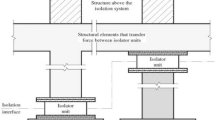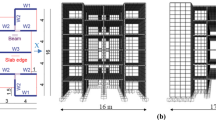Abstract
Purpose
In this paper, a radically new concept of a Stiff Seismic Base Absorber (SBA) is proposed for seismic protection of multistory building structures.
Methods
An inerter is first implemented, connecting directly the structure to the ground. This results in the decrease of the natural frequency of the structure, without decreasing its structural stiffness. Parallel, a negative stiffness-based absorber is used to increase the apparent damping behavior of the inerter. The additional mass of the SBA is connected to the structure with a negative stiffness (NS) element and to the base with a positive one. Also, an artificial damper is placed in parallel with each stiffness element. The design of the SBA includes the following novel features: (1) the SBA foresees variation in all stiffness elements, (2) the optimal system parameters are selected based on engineering criteria with proper constraints and limitations to the system dynamic responses, (3) the earthquake input motion is selected according to the seismic design codes, (4) a displacement-dependent non-linear configuration is proposed for the realization of the NS element, and (5) the detuning phenomena are observed via sensitivity analysis.
Results
Compared to other vibration absorbers, the SBA presents several advantages. An improved superstructure dynamic behavior is observed combined with small base displacements, in the order of a few centimeters.
Conclusion
The drastically reduced base displacements render the implementation of the SBA feasible using conventional structural elements. As a result, the SBA is a realistic retrofitting option for seismic protection.














Similar content being viewed by others
Availability of Data and Material
The data used to support the findings of this study are available from the corresponding author upon request.
Code Availability
The data used to support the findings of this study are available from the corresponding author upon request.
References
Warn GP, Ryan KL (2012) A review of seismic isolation for buildings: historical development and research needs. Buildings 2(3):300–325
Reggio A, Angelis MD (2015) optimal energy-based seismic design of non-conventional Tuned Mass Damper (TMD) implemented via inter-story isolation. Earthq Eng Struct Dyn 44(10):1623–1642
Kangda MZ, Bakre S (2020) Performance evaluation of moment-resisting steel frame buildings under Seismic and Blast-Induced vibrations. J Vib Eng Technol 8(1):1–26
Kunde MC, Jangid RS (2003) Seismic Behavior of Isolated bridges: a-state-of-the-art review. Electron J Struct Eng 3(3)
De Angelis M, Giannini R, Paolacci F (2009) Experimental investigation on the seismic response of a steel liquid storage tank equipped with floating roof by Shaking Table Tests. Earthq Eng Struct Dyn. https://doi.org/10.1002/eqe.945
Paolacci F, Giannini R, De Angelis M (2013) Seismic response mitigation of chemical plant components by passive control techniques. J Loss Prev Process Ind 26(5):924–935
Whittaker AS, Kumar M, Kumar M (2014) Seismic isolation of nuclear power plants. Nucl Eng Technol 46(5):569–580
Chen Y, Yan J, Feng J, Sareh P (2021) Particle swarm optimization-based metaheuristic design generation of non-trivial flat-foldable origami tessellations with degree-4 vertices. J Mech Des. https://doi.org/10.1115/1.4047437
Ma J, You Z (2013) Energy absorption of thin-walled beams with a pre-folded origami pattern. Thin-Walled Struct 73:198–206
Chen Y, Yan J, Feng J (2019) Geometric and kinematic analyses and novel characteristics of origami-inspired structures. Symmetry 11(9):1101
Taniguchi T, Der Kiureghian A, Melkumyan M (2008) Effect of tuned mass damper on displacement demand of base-isolated structures. Eng Struct 30(12):3478–3488
Xiang P, Nishitani A (2014) Optimum design for more effective tuned mass damper system and its application to base-isolated buildings. Struct Control Heal Monit 21(1):98–114
Hashimoto T, Fujita K, Tsuji M and Takewaki I (2015) Innovative base-isolated building with large mass-ratio TMD at basement for greater earthquake resilience. Futur Cities Environ 1:9. https://doi.org/10.1186/s40984-015-0007-6
Wang J-F, Lin C-C, Lian C-H (2009) Two-stage optimum design of tuned mass dampers with consideration of stroke. Struct Control Heal Monit 16(1):55–72
De Domenico D, Ricciardi G (2018) An enhanced base isolation system equipped with Optimal Tuned Mass Damper Inerter (TMDI). Earthq Eng Struct Dyn 47(5):1169–1192
Lazar IF, Neild SA, Wagg DJ (2014) Using an inerter-based device for structural vibration suppression. Earthq Eng Struct Dyn 43(8):1129–1147
De Domenico D, Deastra P, Ricciardi G, Sims ND, Wagg DJ (2019) Novel fluid inerter based tuned mass dampers for optimised structural control of base-isolated buildings. J Franklin Inst 356(14):7626–7649
Taflanidis AA, Giaralis A, Patsialis D (2019) Multi-objective optimal design of inerter-based vibration absorbers for earthquake protection of multi-storey building structures. J Franklin Inst 356(14):7754–7784
Smith MC (2002) Synthesis of mechanical networks: the inerter. IEEE Trans Automat Control 47(10):1648–1662
Carrella A, Brennan MJ, Waters TP (2007) Static analysis of a passive vibration isolator with quasi-zero-stiffness characteristic. J Sound Vib 301(3–5):678–689
DeSalvo R (2007) Passive, nonlinear, mechanical structures for seismic attenuation. J Comput Nonlinear Dyn 2(4):290
Iemura H, Pradono MH (2009) Advances in the development of pseudo-negative-stiffness dampers for seismic response control. Struct Control Heal Monit 16(7–8):784–799
Pasala DTR, Sarlis AA, Nagarajaiah S, Reinhorn AM, Constantinou MC, Taylor D (2013) Adaptive negative stiffness: new structural modification approach for seismic protection. J Struct Eng 139(7):1112–1123
Sun T, Lai Z, Nagarajaiah S, Li HN (2017) Negative stiffness device for seismic protection of smart base isolated benchmark building. Struct Control Heal Monit 24(11):e1968. https://doi.org/10.1002/stc.1968
Shen Y, Peng H, Li X, Yang S (2017) Analytically optimal parameters of dynamic vibration absorber with negative stiffness. Mech Syst Signal Process 85:193–203. https://doi.org/10.1016/j.ymssp.2016.08.018
Wang M, Sun F, Yang J, Nagarajaiah S (2019) Seismic protection of SDOF systems with a negative stiffness amplifying damper. Eng Struct 190:128–141. https://doi.org/10.1016/j.engstruct.2019.03.110
Wang M, Sun F, Nagarajaiah S (2019) Simplified optimal design of MDOF structures with negative stiffness amplifying dampers based on effective damping. Struct Des Tall Spec Build 28(15):e1664. https://doi.org/10.1002/tal.1664
Shi X, Zhu S (2019) A comparative study of vibration isolation performance using negative stiffness and inerter dampers. J Franklin Inst 356(14):7922–7946
Yang X, Zheng J, Xu J, Li W, Wang Y, Fan M (2020) Structural design and isolation characteristic analysis of new quasi-zero-stiffness. J Vib Eng Technol 8(1):47–58
Antoniadis IA, Kanarachos SA, Gryllias K, Sapountzakis IE (2018) KDamping: a stiffness based vibration absorption concept. J Vib Control 24(3):588–606
Kapasakalis K, Antoniadis I, Sapountzakis E (2019) Implementation of the KDamper as a stiff seismic absorption base: a preliminary assessment. Vib Acoust Res J 1(1)
Kapasakalis K, Antoniadis I and Sapountzaki A (2019) Implementation of the KDamper concept for seismic protection of bridges. In: Proceedings of the 14th International Conference on Vibration Problems (ICOVP 2019)
Kapasakalis K, Sapountzakis E and Antoniadis I (2017) Implementation of the KDamper concept to wind turbine towers. In: Proceedings of the 6th International Conference on Computational Methods in Structural Dynamics and Earthquake Engineering (COMPDYN 2017)
Kapasakalis K, Sapountzakis E and Antoniadis I (2018) Optimal design of the KDamper concept for structures on compliant supports. In: Proceedings of the 16th European Conference on Earthquake Engineering (16ECEE 2018)
Kapasakalis KA, Antoniadis IA, Sapountzakis EJ, Kampitsis AE (2021) Vibration mitigation of wind turbine towers using negative stiffness absorbers. J Civ Eng Constr 10(3):123–139
Kapasakalis K Sapountzakis E and Antoniadis I (2018) KDamper concept in seismic isolation of multi storey building structures. In: Proceedings of the 9th GRACM International Congress on Computational Mechanics (9GRACM 2018)
Kapasakalis K, Sapountzakis E and Antoniadis I (2018) Kdamper concept in seismic isolation of building structures with soil structure interaction. In: Proceedings of the 13th International Conference on Computational Structures Technology (CST2018)
Kapasakalis KA, Antoniadis IA and Sapountzakis EJ (2021) STIFF vertical seismic absorbers. J Vibr Control 1–13. https://doi.org/10.1177/10775463211001624
Kapasakalis K, Antoniadis I and Sapountzakis E (2019) Control of multi storey building structures with a new passive vibration control system com-bining base isolation with KDamper. In: Proceedings of the 7th International Conference on Computational Methods in Structural Dynamics and Earthquake Engineering (COMPDYN 2019)
Kapasakalis K, Antoniadis I and Sapountzakis E (2019) Novel vibration absorption systems with negative stiffness elements for the seismic protection of structures. In: 4th National Conference on Earthquake Engineering and Engineering Seismology (Hellenic Association for Earthquake Engineering - HAEE/ETAM)
Kapasakalis K, Antoniadis I, Sapountzakis E (2019) Performance assessment of the KDamper as a seismic absorption base. Struct Control Heal Monit 27(4):e2482. https://doi.org/10.1002/stc.2482
Kapasakalis KA, Antoniadis IA, Sapountzakis EJ (2021) A soil-dependent approach for the design of novel negative stiffness seismic protection devices. Appl Sci 11(14):6295
Geem ZW, Kim JHn, Loganathan GV (2001) A new heuristic optimization algorithm: harmony search. SIMULATION 76(2):60–68
Seismosoft [2018] (2018) SeismoArtif—a computer program for generating artificial earthquake accelerograms matched to a specific target response spectrum. http://www.seismosoft.com. Accessed 7 July 2018
Kapasakalis KA, Antoniadis IA, Sapountzakis EJ (2021) Constrained optimal design of seismic base absorbers based on an extended KDamper concept. Eng Struct 226:111312
Fluid Viscous Dampers | Seismic Dampers | ITT Infrastructure | ITT Enidine. https://www.itt-infrastructure.com/en-US/Products/Viscous-Dampers/. [Accessed: 22-Jan-2020]
Elastomeric Isolators - Fip Industriale. https://www.fipindustriale.it/index.php?area=106&menu=67&lingua=1. [Accessed: 22-Jan-2020]
Acknowledgements
This research has been co-financed by the European Union and Greek national funds through the Operational Program Competitiveness, Entrepreneurship and Innovation, under the call RESEARCH – CREATE – INNOVATE (project code: T1EDK-02827).
Funding
Not applicable.
Author information
Authors and Affiliations
Contributions
KAK: conceptualization, methodology, software, formal analysis, investigation, resources, data curation, writing—original draft, visualization. IAA: validation, writing—review and editing, project administration, funding acquisition. EJS: supervision.
Corresponding author
Ethics declarations
Conflict of Interest
The authors declare there are no conflicts of interest regarding the publication of this paper.
Additional information
Publisher's Note
Springer Nature remains neutral with regard to jurisdictional claims in published maps and institutional affiliations.
Rights and permissions
About this article
Cite this article
Kapasakalis, K.A., Antoniadis, I.A. & Sapountzakis, E.J. Feasibility Assessment of Stiff Seismic Base Absorbers. J. Vib. Eng. Technol. 10, 37–53 (2022). https://doi.org/10.1007/s42417-021-00362-2
Received:
Revised:
Accepted:
Published:
Issue Date:
DOI: https://doi.org/10.1007/s42417-021-00362-2




